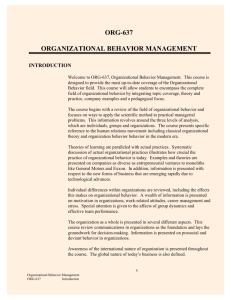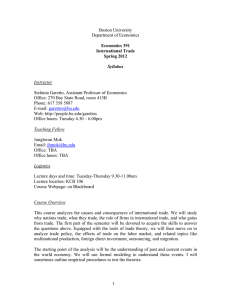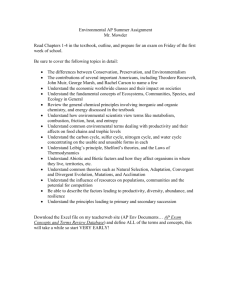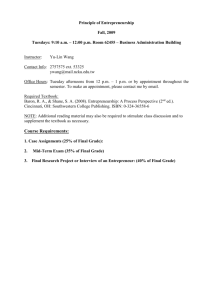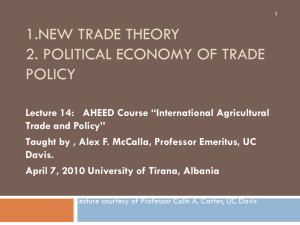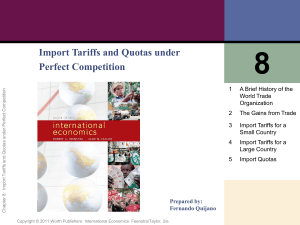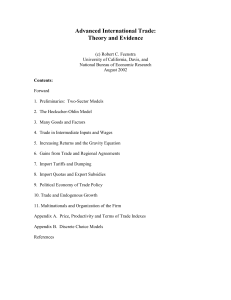Paul H. Nitze SAIS Bologna Center Johns Hopkins University
advertisement
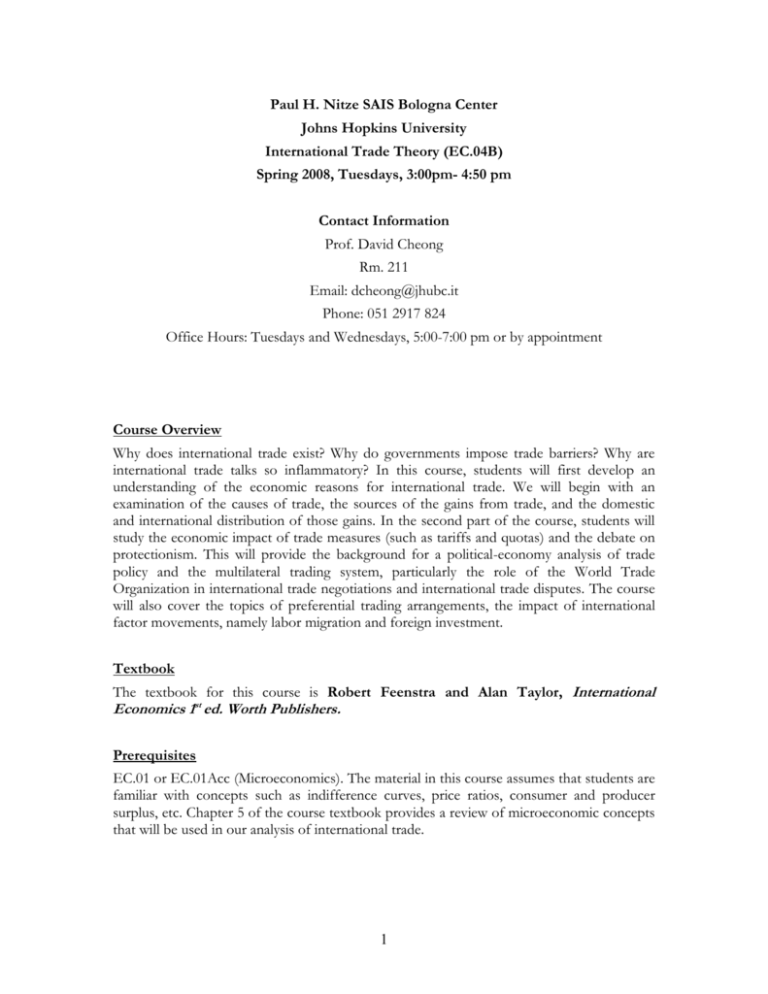
Paul H. Nitze SAIS Bologna Center Johns Hopkins University International Trade Theory (EC.04B) Spring 2008, Tuesdays, 3:00pm- 4:50 pm Contact Information Prof. David Cheong Rm. 211 Email: dcheong@jhubc.it Phone: 051 2917 824 Office Hours: Tuesdays and Wednesdays, 5:00-7:00 pm or by appointment Course Overview Why does international trade exist? Why do governments impose trade barriers? Why are international trade talks so inflammatory? In this course, students will first develop an understanding of the economic reasons for international trade. We will begin with an examination of the causes of trade, the sources of the gains from trade, and the domestic and international distribution of those gains. In the second part of the course, students will study the economic impact of trade measures (such as tariffs and quotas) and the debate on protectionism. This will provide the background for a political-economy analysis of trade policy and the multilateral trading system, particularly the role of the World Trade Organization in international trade negotiations and international trade disputes. The course will also cover the topics of preferential trading arrangements, the impact of international factor movements, namely labor migration and foreign investment. Textbook The textbook for this course is Robert Feenstra and Alan Taylor, International Economics 1st ed. Worth Publishers. Prerequisites EC.01 or EC.01Acc (Microeconomics). The material in this course assumes that students are familiar with concepts such as indifference curves, price ratios, consumer and producer surplus, etc. Chapter 5 of the course textbook provides a review of microeconomic concepts that will be used in our analysis of international trade. 1 Course Schedule The table below contains dates for lectures, distribution and submission of problem sets, and the mid-term exam. The date of the final exam will be set by the Registrar. For each lecture, students are required to prepare by reading the relevant textbook chapter(s) (FT = Feenstra and Taylor). The other readings listed are recommended, and some will be used for class discussion. Class Dates 12-Feb 19-Feb 26-Feb 4-Mar 11-Mar 1-Apr Lecture Topics and Readings INTRODUCTION FT Chapter 1 THEORIES OF INTERNATIONAL TRADE (The "Classical" or Ricardian Theory) FT Chapter 2 Problem Set 1 Distributed Krugman, Paul (1997), “Ricardo’s difficult idea”, http://web.mit.edu/krugman/www/ricardo.htm Carlin, Wendy, Glyn, Andrew, and Van Reenen, John (2001), “Export Market Performance of OECD Countries: An Empirical Examination of the Role of Cost Competitiveness” Economic Journal. THEORIES OF INTERNATIONAL TRADE (The Specific Factors Model) FT Chapter 3 Problem Set 1 Due THEORIES OF INTERNATIONAL TRADE (The Hecksher-Ohlin Model) FT Chapter 4 (4.1-4.3) THEORIES OF INTERNATIONAL TRADE (Applications and Empirical Tests of the HecksherOhlin Model) FT Chapter 4 (4.4 and Appendix) Problem Set 2 Distributed Trefler, Daniel (1993), “International factor price differences: Leontief was right!” Journal of Political Economy. Freeman, Richard B. (1995), “Are Your Wages Set in Beijing?” Journal of Economic Perspectives Slaughter, Matthew J., and Swagel, Phillip (1997), “Does Globalization Lower Wages and Export Jobs?” Economic Issues No. 11, IMF. On the IMF web site (www.imf.org/external/pubs/ft/issues11/index.htm) Greenaway, David and Nelson, Douglas (2000), “The assessment: globalization and labour-market adjustment”, Oxford Review of Economic Policy THEORIES OF INTERNATIONAL TRADE (Demand, Technological Change, Scale Economies, Imperfect Competition, Firm-Level Characteristics) FT Chapter 6 Problem Set 2 Due 2 8-Apr 15-Apr 22-Apr 29-Apr 6-May Krugman, Paul (1979), “Increasing Returns, Monopolistic Competition, and International Trade,” Journal of International Economics. Helpman, Elhanan (1999), The Structure of Foreign Trade, Journal of Economic Perspectives. Bernard, Andrew. B., Jensen, J. Bradford, and Schott, Peter. K. (2005), “Importers, Exporters, and Multinationals: A Portrait of Firms in the U.S. that Trade Goods”, NBER Working Paper No. 11404 Mid-Term Exam THE THEORY AND PRACTICE OF COMMERCIAL POLICY: Tariffs and Quotas under Perfect Competition FT Chapter 8 Problem Set 3 Distributed Feenstra, Robert C. (1992), “How Costly is Protection?” Journal of Economic Perspectives. THE THEORY AND PRACTICE OF COMMERCIAL POLICY: Tariffs and Quotas under Imperfect Competition FT Chapter 9 Problem Set 3 Due Schott, Jeffrey J. (2005), “Confronting Current Challenges to US Trade Policy”, Chapter 8 in “The United States and the World Economy: Foreign Economic Policy for the Next Decade” edited by C. Fred Bergsten, the Institute for International Economics. Mankiw, Gregory N. (2005) “Antidumping: The Third Rail of Trade Policy,” Foreign Affairs. THE THEORY AND PRACTICE OF COMMERCIAL POLICY: Export Subsidies in Agriculture and Hi-Tech Industries FT Chapter 10 INTERNATIONAL TRADE AGREEMENTS FT Chapter 11 Problem Set 4 Distributed Baldwin, Robert E. (1997), “The causes of regionalism”, The World Economy. World Bank (2000), “Trade Blocs”. World Bank (2004), “Global Economic Prospects, 2005: Trade, Regionalism, and Development”. Krugman, Paul (1997), “What should trade negotiators negotiate about?” Journal of Economic Literature. 3 13-May TRADE, GROWTH, AND DEVELOPMENT Problem Set 4 Due Hallak, Juan Carlos and Levinsohn, James (2004), “Fooling Ourselves: Evaluating the Globalization and Growth Debate,” 2004, Mimeo http://www.umich.edu/~jamesl/FO_7.doc Hertel, Thomas W. and Winters, L. Alan (2005), “Poverty Impacts of A WTO Agreement: Synthesis and Overview,” Chapter 1 in Poverty and the WTO: Impacts of the Doha Development Agenda, http://siteresources.worldbank.org/INTTRADERESEARCH/Resources/Overview PovWTO.pdf Winters, L. Alan. 2004. “Trade Liberalization and Poverty: The Evidence So Far.” Journal of Economic Literature. 20-May INTERNATIONAL FACTOR MOVEMENTS AND FOREIGN OUTSOURCING FT Chapters 5 and 7 Blomstrom, M. and Kokko, A (1997), “How Foreign Direct Investment Affects Host Countries”, World Bank Policy Research Working Paper Series, No. 1745 Aitken B and Harrison A (1999), “Do Domestic Firms Benefit from Direct Foreign Investment? Evidence from Venezuela”, American Economic Review, 89, 605-18. Lewis, Ethan (2005), “How Do Local Labor Markets in the U.S. Adjust to Immigration?” Federal Reserve Bank of Philadelphia, Business Review. (www.phil.frb.org/files/br/brq105el.pdf). Borjas, George (2005), “The Labor-Market Impact of High-Skill Immigrants,” American Economic Review (http://ksghome.harvard.edu/~GBorjas/Papers/w11217.pdf). 4 Course Evaluation Problem Sets (20%) There will be four problem sets assigned during the semester. Each will make up 5% of your final grade. These assignments are meant to advance your understanding of the models studied in the course. You will have one week to complete each problem set once it is assigned. You are encouraged to work in groups of not more than 3 members. Exams (70%) This course will have one mid-term and one final exam, each making up 30% and 40% respectively of your final grade. Participation (10%) Students are actively encouraged to participate in lectures and course activities. The assessment will be based on the quality of comments made during class and contributions to extra-class activities. Review Sessions There will be weekly one-hour review sessions led by our teaching assistants, in which students will test their comprehension of the lecture material by solving problems related to the week’s lecture. These practice problems will enable students to focus on and apply key ideas and concepts. Communication As the class meets only once a week, I will use email to make any urgent announcements or carry on any prematurely-ended class discussions. So, please check your email regularly. If you wish to contact me, my coordinates and contact details are on the first page of this syllabus. You are welcome to see me during my office hours without an appointment. If you would like to see me at other times, please email me to fix an appointment. Email is the most efficient means of communicating with me outside of class or office hours. 5
